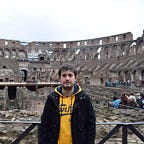Learning history of art and searching for its purpose
I started learning history of art with a visit to Vatican Museums. I was fascinated by works of Michelangelo on Sistine Chapel’s ceiling. I did not even know that Creation of Adam was a ceiling painting and it is there before entering the chapel. But I was also lucky because I had bought museum guide book before entering and read all the descriptions of the celling’s painting while sitting inside the Chapel.
When I left Rome, I promised myself that when I visit Italy second time, I will learn Latin and as much as possible regarding art. Since then, I tried hard to learn about artists, paintings and sculpture. Firstly, I started reading books dedicated to life of one artist only. But every book was mentioning other patrons and artists. Thus, I learnt about Medici family and Lorenzo de’ Medici.
Reading art was getting more excited when I learnt the assassination of Giuliano de’ Medici, in the Cathedral of Santa Maria del Fiore, which Medici family invested heavily to complete its dome.
Story caught my attention even more when I learnt that murderer of Giuliano de’ Medici escaped to a Turkish city, Istanbul. He got caught there and extradited to Republic of Florence and got hanged. Organizer of the assassination was Francesco de’ Pazzi, a rival of Medici family. He also was hanged on the same day of the assassination.
Learning that helped me make connection with a scene from the movie Hannibal in which my favorite actor Antony Hopkins features.
Every book I read was referring another artist Georgia Vasari. He is the author of the book “Lives of the Most Excellent Painters, Sculptors, and Architects” and he is accepted as first art historian. In his book, I learnt many new names including Cimabue, Giotto, Fra Angelico, Masaccio and Ghiberti.
The book taught me Ghiberti’s masterpiece gates of Baptistery of Saint John in Florence, which Michelangelo named as “Gates of Paradise” immediately after he saw it for the first time. I am great admirer of Ghiberti and his reliefs on the gates. My plan is go to Florence and look every relief and understand every story depicted in the reliefs. I can spend hours in front this door.
Watch Khan Academies perfect presentation about Ghiberti’s masterpiece for more information.
As I was learning more and more, I started questioning the drive behind the motivation of those artists. Was the reason to earn money to make a living like Rembrandt after his bankruptcy? or Was it passion like Van Gogh’s even though his works never were admired when he was alive? or Was it expressing your style through your art in a way that you like, not your patron wants just like Caravaggio did? Was art a tool for communist propaganda as Picasso claimed it to be? What made Leonardo dig graves and work anatomy on corpses he pulled from graves?
I think there is no single answer to these questions and motivation depends on the artists and times. But I love artists who both reflect their style and introduce their culture through their work the most. Therefore, these days my number one artist is the Dutch artist Pieter Bruegel the Elder. When I saw his painting Dutch Proverbs for the first time, I did not get any idea about the painting. Here is the painting:
Let’s inspect the following small part from the picture. You may wonder why woman numbered with 1 is tying the devil or why is guy numbered with 2 is bitting the column or why is the guy numbered with 5 pushing his head to the wall. If you see this picture for the first time, probably it will seem a bit meaningless. But there is a great genius in the picture. Bruegel painted literal meanings of Dutch proverbs in the picture.
Here is the meanings:
1- She bound the devil to a cushion| She’s a real shrew
2- He is a column biter|He’s a false friend/ a religious hypocrite
5- To bang one’s head against a brick wall|To try to achieve the impossible
Brugel managed to squeeze more than 50 proverbs to one paintings. In my opinion, he perpetuated dutch proverbs through his art.
Before learning history of art, my favorite artist was Leonardo da Vinci. At some point, I appreciated Rembrandt and Caravaggio’s work more. These days it is Brugel. As I learn, my favorite artist changes constantly but it looks like Brugel’s place is formidable on my list.
